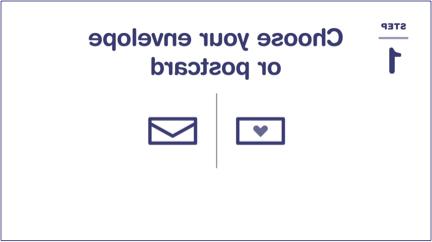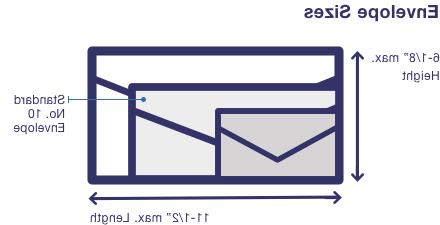
Image of play button
Find out how to send mail.1:53
Video Description: How to Send a Letter or Postcard (TXT 4 KB)
How to Send a Letter or Postcard: Domestic
Sending a letter with USPS® is easy! Our video will help you with most letters and postcards you send domestically (inside the U.S.), including U.S. territories and military bases in the U.S. and abroad.
For how to ship a package, see How to Send a Package: Domestic.

Image of play button
Find out how to send mail.1:53
Video Description: How to Send a Letter or Postcard (TXT 4 KB)
Send Mail: Step-by-Step Instructions
Expand All
Step 1: Choose Envelope or Postcard
Envelopes are for sending flat, flexible things, like letters, cards, checks, forms, and other paper goods. For just 1 $0.73 First-Class Mail® Forever® stamp, you can send 1 oz (about 4 sheets of regular, 8-1/2" x 11" paper in a rectangular envelope) to anywhere in the U.S.!

Envelopes must be rectangular and made of paper to qualify for letter prices. Your envelope can be a maximum of 11-1/2" long x 6-1/8" high. (A standard No. 10 envelope is 9-1/2" long x 4-1/8" high.) You can fold what you put in your envelope, but it needs to stay flat—no more than 1/4" thick.
If you want to send letter-sized papers without folding them, you can use a large envelope (called a "flat"); the postage for flats starts at $1.50. If your large envelope is nonrectangular, rigid (can't bend), or lumpy (not uniformly thick), you'll have to pay the package price.
TIP: If your envelope can't fit through USPS mail processing machines, or is rigid, lumpy or has clasps, string, or buttons, it's "nonmachinable" and you'll have to pay $0.46 more to send it. (See additional postage in Step 3.) You'll also have to pay more if your envelopes are square or vertical (taller than they are wide).
Postcards are for short messages that you don't need to put in an envelope. Save money using a $0.56 postcard stamp to send a standard-sized postcard anywhere in the U.S. Standard postcards are usually made of paper, are between 5" to 6" long and 3-1/2" to 4-1/4" high, and are between 0.007" and 0.016" thick.
Size & Weight Requirements – Postcards & Envelopes
Step 2: Address Your Mail
Envelopes: Write your address (the "return" or "sender" address) in the top left corner. Write the delivery address (the "recipient" address) in the bottom center.
Postcards: Postcards come in different formats, so write the delivery address in the space it gives you (on the same side you write your message and put the stamp).
Print your return address and the delivery address clearly, in the correct spots, to make sure your mail is delivered on time.
Address Format Tips
- Print addresses neatly in capital letters.
- Use a pen or permanent marker.
- Do not use commas or periods.
- Include the ZIP+4® Code whenever possible.
Write Sender Address
Write your address (the "return address") in the top-left corner. Include the following on separate lines:
- Your full name or company name
- Apartment or suite number
- Full street address
- City, State, and ZIP+4 Code
Write Delivery Address
Write the delivery address (the "recipient" address) in the bottom center of the envelope. Include the following on separate lines:
- Recipient's full name or company name
- Apartment or suite number
- Full street address
- City, State, and ZIP+4 Code
Special U.S. Addresses
Puerto Rico
Some Puerto Rico addresses include an urbanization or community code for a specific area or development. Addresses with an urbanization code, abbreviated URB, should be written on 4 lines:
MS MARIA SUAREZ
URB LAS GLADIOLAS
150 CALLE A
SAN JUAN PR 00926-3232
More Puerto Rico Address Examples
U.S. Virgin Islands
Virgin Islands addresses have the same format as standard addresses. The right abbreviation for this territory is "VI," not "US VI" or "USA VI":
MS JOAN SMITH
RR 1 BOX 6601
KINGSHILL VI 00850-9802
Military and Diplomatic Mail (APO/FPO/DPO)
Mail to military and diplomatic addresses is treated differently:
- Do not include the city or country name when you send something to an APO/FDO/DPO address in another country. This keeps your mail out of foreign mail networks.
- Do include unit and box numbers if they're assigned:
SEAMAN JOSEPH SMITH
UNIT 100100 BOX 4120
FPO AP 96691
More Details on Military Addresses
When you're done addressing your envelope, put what you're sending inside the envelope, then close and seal it (using the envelope's glue or tape).

Step 3: Calculate Postage (& Add Insurance or Extra Services)
A First-Class Mail® Forever stamp costs $0.73 and goes in the upper right corner of the envelope. (You can also use any combination of stamps that adds up to $0.73.)
If your letter is heavier or bigger, or if you want to add insurance or extra services like Certified Mail® service, you'll pay more.
A standard postcard stamp costs $0.56. (Large or square postcards will cost more.) Put the postcard stamp in the space provided near the delivery address.
Postage for letters mostly depends on weight and size/shape. You can weigh your letter with a kitchen scale, postal scale, at a self-service kiosk, or at the Post Office™ counter.
TIP: As a rule of thumb, you can send 1 oz (4 sheets of printer paper and a business-sized envelope) for 1 First-Class Mail® Forever® stamp (currently $0.73).
The postage for a large envelope (or flat) starts at $1.50 for 1 oz.
Where Can I Buy Postage?
- The Postal Store®
Shop online for all stamps and add-on postage for oversized or heavier envelopes. - Post Office Locations
Buy stamps at Post Office locations, self-service kiosks, or at National Retailers such as grocery and drug stores.
TIP: If you're sending larger envelopes (flats) using Priority Mail® or Priority Mail Express® service, you can use Click-N-Ship® service to pay for and print your own postage online.
Additional Postage
If your envelope weighs over 1 oz, you can buy additional postage in the amount you need:
- For letters up to 3.5 oz, each additional 1 oz is $0.28.
- For large envelopes up to 13 oz, the price varies for each additional 1 oz.
- Nonmachinable items, including envelopes that are lumpy or rigid, or have clasps, string, or buttons will cost $0.46 more to send. You'll also have to pay more if your envelopes are square or vertical (taller than they are wide).
- You can also buy 1¢, 2¢, 3¢, 4¢, 5¢, and 10¢ stamps at The Postal Store.
TIP: Put the stamp on last; that way, if you make a mistake at any other point, you won't waste a stamp.
Add-On Services
If you want insurance, proof of delivery, signature services, or other optional services, you'll have to pay extra.
Our Insurance & Extra Services page has more details; some of the more common add-on services for letters include:
- Certified Mail®: Get proof that you mailed your item and that the recipient signed for it.
- Registered Mail®: USPS's most secure mail service–mail is processed manually, handled separately and securely, and signed for along every step of its journey. The recipient must sign for the mail to confirm delivery (or attempted delivery).
- Return Receipt: You'll get a printed or emailed delivery record showing the recipient's signature. You can combine Return Receipt with other services, including Certified Mail, Registered Mail, Priority Mail Express® service, and more.
- Adult Signature Required: Only an adult (age 21+) can sign for the mail after showing a valid government ID.

Step 4: Send Your Mail
Once your envelope or postcard has the correct addresses and postage, you can send it several ways, including putting it in your mailbox or dropping it in a blue collection box or at a Post Office™ location.
- Put your letter inside your mailbox and raise the flag (if you have one).
- If you have a cluster mailbox, drop it in the outgoing mail slot.
- Drop it off in a blue collection box.
- Take it to a Post Office lobby drop.
Important Note: If your envelope has postage stamps and weighs more than 10 oz or is thicker than 1/2", you can't put it in a collection box; you have to give it to an employee at a Post Office location. See more details on What Can and Cannot be Deposited in a Collection Box?
Post Offices & Drop-Off Locations
Bonus: Sending Mail Pro Tips
The Postal Service uses high-speed sorting machines to help process and deliver 425.3 million mail pieces each day. Here are some extra tips to improve your mail sending experience:
- Stay flexible: Don't send rigid (hard) objects in paper envelopes.
- Sending embellished invitations (for weddings, graduations, etc.)? Get them hand-canceled or put them inside another envelope.
- Need tracking? Learn about your options.

Stay Flexible
Postcards, letter envelopes, and large envelopes (flats) all need to bend to fit through USPS® high-speed sorting machines.
- OK: Flexible, flat things like stickers, photos, trading cards, etc. should be okay—as long as your envelope stays flat, not lumpy, and less than 1/4" thick.
- Not OK: Don't put rigid objects (like flash drives, coins, keys, hard plastic card cases, etc.) loose in unpadded paper envelopes: They could get torn out of the envelope, jam the sorting machines, cause a delay, or even get lost.
Instead, for rigid and odd-shaped objects (or things you don't want to get bent), we recommend using a padded envelope or small box and sending it as a package.

Sending Embellished Invitations (for Weddings, Graduations, etc.)
If you want to send a specially decorated envelope (like some wedding invitations):
- You can pay the extra fee for nonmachinable First-Class Mail® items, bring your mail to the Post Office™ counter, and ask the retail associate to hand-cancel your embellished invitations.
- For externally decorated invitations: If you use wax seals, strings, ribbons, etc. on your envelopes, don't try to send them exposed. Instead, to make sure your envelopes arrive looking the way your designer intended, put them inside another envelope.
Need Tracking?
Tracking is not available for First-Class Mail items. If you'd like to get tracking information for your letter:
- You can pay extra to send your letter using Priority Mail Express® or Priority Mail® service.
- You can get delivery confirmation by adding Certified Mail® or Registered Mail® service. (You can even combine it with Return Receipt if you want the recipient's signature.)



